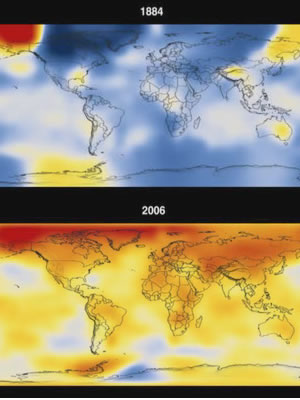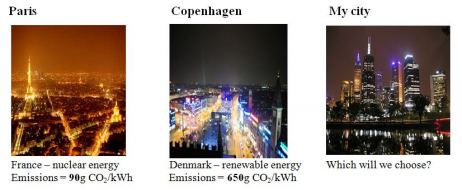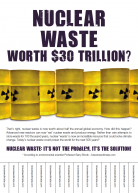Two countries, two paths, one crucial lesson learned
————————————————
Resources
Read this printable pamphlet (PDF file) on why nuclear power is needed to combat climate change. It’s double-sided and folds 3 ways. For more information on its development, read this.
In addition, print these posters and put them up where people can take notice of them! If you don’t understand them, or don’t believe them, read below…
Poster #1: If You’re Serious About Climate Change, Get Serious About Nuclear Power
Poster #2: Nuclear Power or Climate Change — You Choose
Poster #3: Nuclear Waste — It’s Not the Problem, It’s the Solution (also this one [less graphical])
Poster #4: Wind and Solar — Not Replacing Coal
Poster #5: Renewables or Nuclear — Which Means Action on Climate Change?
You can also order a t-shirt with these themes printed on the front at Climate Sanity.
————————————————
Frequently Asked Questions about climate change and sustainable energy
 Climate change basics I – observations, causes and consequences
Climate change basics I – observations, causes and consequences
The longer we delay on the move away from fossil fuel energy sources, the more we will ‘lock in’ the build-up of long-lived greenhouse gases like carbon dioxide.
To have a 50:50 chance of avoiding 2°C or more global warming, carbon emissions must be slashed by around 80% by 2050 and essentially eliminated in the few decades after that. It will take time to make this massive, worldwide transition to new energy sources. We have no time to lose!
————————————————
Climate change basics II – impacts on ice, rain and seas
The term “global warming” says it all – a heating of the atmosphere right across the world. But that does not mean that the warming, or its impacts, will be the same everywhere. Regional and local differences can cause things to be worse, or better, depending on where you are.
————————————————
Climate change basics III – environmental impacts and tipping points
It has been estimated that 20 to 60 per cent of species might become extinct in the next few centuries, if global warming of more than a few degrees occurs. Many thousands (perhaps millions) will be from tropical areas, about which we know very little. A clear lesson from the past is that the faster and more severe the rate of global change, the more devastating the biological consequences.
————————————————
Take real action on climate change – Part 1: The strategy
Our Primary Goal
Avert catastrophic climate change.
Our Secondary Goal: in pursuit of our primary goal
Remove the ban on nuclear power in Australia and include it as an assessable option in our climate change mitigation strategy.
Take Action
 ● Print out and sign our posters and petition (see below).
● Print out and sign our posters and petition (see below).
● With a permanent marker write your favorite pro-nuclear power slogan across your T-shirt. Wear it everywhere.
● Get rebellious, attend a climate rally carrying a pro-nuclear power placard.
● Speak up. Discuss nuclear power as a response to climate change with your friends, family and the annoyingly chatty passenger who keeps sitting next to you the train.
● Write letters to the newspaper, to your local MP or Minister for resources and energy, etc.
————————————————
 Take real action on climate change – Part 2: The FAQ
Take real action on climate change – Part 2: The FAQ
Here, a list of frequently asked questions (FAQ) on climate change and nuclear energy are answered.
These are quite deliberately not technical – you won’t find explanations of adiabatic lapse rates, actinide isotopes or Brayton cycle efficiency here! Nope… these are ‘big picture’ questions. I hope you find them stimulating, easy to understand, and appropriate to their target audience – the average ‘Joe’ and ‘Josephine’.
 The 20 big questions
The 20 big questions
Q1. How urgent is it to address climate change?
Q2. Why do we need nuclear power? Won’t renewables provide our needs?
Q3. We need to act fast, aren’t renewables the fastest response?
Q4. Aren’t renewables the most affordable option?
Q5. What about storing excess energy for later use?
…
————————————————
A checklist for renewable energy plans
Beyond Zero Emissions recently launched their Zero Carbon Australia 2020Stationary Energy Plan. It joins a growing list of renewable energy plans –Desertec, Greenpeace’s Energy [R]evolution, World Wildlife Fund Australia’s Clean Energy Future, Peter Seligman’s Australian Sustainable Energy, and others around the world.
The need to cut ourselves loose from our carbon based economy is urgent, and proponents of these plans are to be applauded. But, can they work? Many posts and comments at Brave New Climate have focussed on the hurdles facing large scale renewable power. Here I have tried to distill these points into a checklist to bear in mind when considering these plans. The list is followed by some brief exposition of each item. Some of these items refer to some Australian specifics, but similar questions will arise in other countries.
These items are not a set of pass/fail criteria, rather, they are prompts to ask “Did the plan address this point, and how?” The list is not exhaustive – many other questions could be raised, and hopefully will be in the comments. I have not really considered nuclear power in this list because I am not aware of similar comprehensive attempts to plan carbon free nuclear economies (perhaps there should be) – there would be questions, but unlike renewable energy, we have existence proofs that it can be done.
So, how does the plan check out?
0. The checklist
□ What is the emissions reduction target?
□ What is the budget for the plan?
□ How is the plan to be financed?
□ What is the cost of power if the plan is implemented?
□ What is the CO2 avoidance cost ($/tCO2 avoided)
…






.png)







FAQ is updated, with 4 posters now listed at the top of the page, and the two “Take Action on Climate Change” posts updated to reflect the suggestions in comments.
I have now updated the FAQ to include John Morgan’s excellent ‘A checklist for renewable energy plans’. It’s an integral part of BNC’s mantra — think critically about sustainable energy and accept nothing at face value!
[…] F.A.Q. […]
[…] F.A.Q. […]
[…] F.A.Q. […]
[…] F.A.Q. […]
Posters #1 and #4 have been updated, with improved wording and now downloadable as high-quality PDFs. Thanks to Marion and Ms Perps.
The ‘less graphical’ version of the nuclear waste poster is also less factual. It says nuclear waste is worth $30 billion, whereas my understanding is it is worth 1000 times more!
Thanks EN for pointing out my slip-up – of course it should read – $30 Trillion as per your original poster. Sorry:)
Barry could you please correct the less graphical poster.
The $30 trillion poster is now updated. Thanks for picking this up.
[…] F.A.Q. […]
Can we create a water pump systems in these nuclear plants that do not need electricity for the water pumps to operate. I am thinking that the steam created by the heat generated from the nuclear rods could be transmitted mechanically to water pumps for them to keep cycling water to coold the nuclear rods. If this is not a very efficient way of cooling the system, at least it should be in place for emergency situations. I would like to hear some explanation from the people who engineer this nuclear plants.